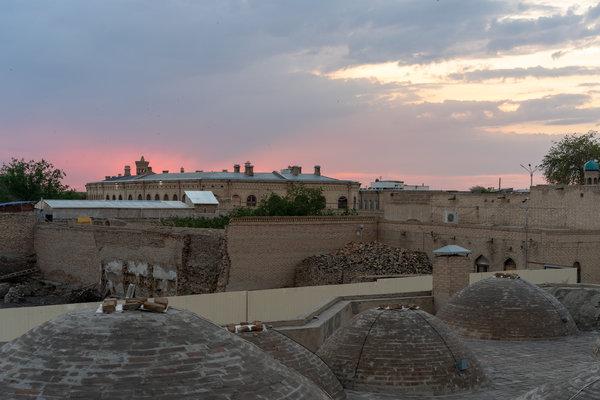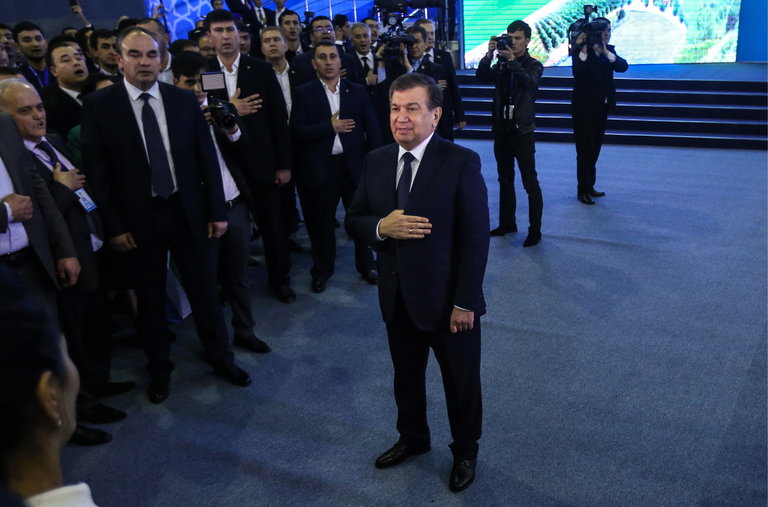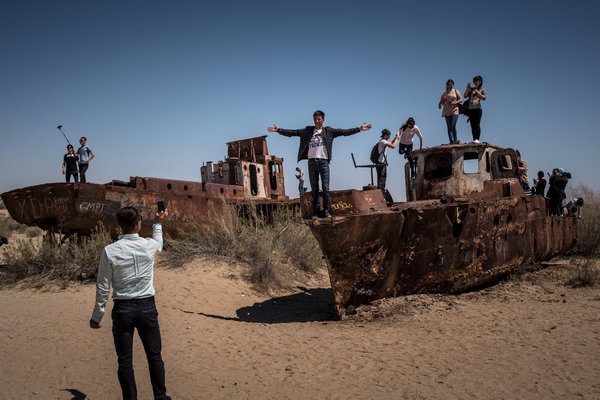Our columnist, Sebastian Modak, is visiting each destination on our 52 Places to Go in 2019 list. He has been traveling in Uzbekistan, after a stop in Doha, Qatar.
I’m in the back of a rusty trailer attached to a Soviet-era tractor with six Uzbek men and a dead goat. The air smells of horses and sweat, and when my teeth hit each other, I can feel the crunch of fine dust in my mouth. The tractor moves into the middle of an empty field, a snow-capped mountain range dominating the horizon. We’re being pursued by a horde of men on horseback packed into a scrum so dense it’s hard to tell which man is riding which horse. Then, two men in the trailer lift the goat carcass, made heavier by the salt it’s stuffed with, and drop it into the dust. The shouts of the horsemen get louder and it’s a frenzy. With stiff riding crops in hand, they whip their horses, each other’s horses, and each other.
This is kopkari, also known as buzkashi, a sport originating at least 1,000 years ago with the nomadic Turkic groups who inhabited the Central Asian steppes. Versions of the game vary slightly from country to country, but here in Uzbekistan, the rules are few and straightforward. The 200 riders compete to pick up the stuffed goat carcass, bending down from their horses, and bring it to a target, a circle of hay placed in front of the announcer’s box. Each round has a pot of winnings to which spectators contribute; sometimes money, oftentimes a handwoven carpet or even a horse.

For centuries, Bukhara was a center of Islamic scholarship and global trade. Much of that history still remains in madrasas, mosques and marketplaces.CreditSebastian Modak/The New York Times
I was brought to the event by a guide-turned-friend, Hurshid Narimov, head of Tourbee’n, a tourism company, who drove me from the city of Samarkand, promising “something special.” The highway into the district of Bulungur gave way to dirt after about an hour, and coming up a hill, I caught my first sight of the festivities: thousands of men sitting on the hillside looking down onto the field. A comparatively small number of women were watching from a section on the other side of the natural amphitheater.
“You’re one of very few travelers to have a chance to enjoy this beauty,” Mr. Narimov told me, as we made our way to the field. “You will be the only foreigner among thousands who will be there.”
And that I was. I didn’t go unnoticed: My presence was quickly announced over the loudspeaker and at one point I was given the microphone. Instead of discomfort in the spotlight, I felt an overwhelming sense of welcome. People smiled and waved, encouraging me to get closer to the action. At least 15 people approached me throughout the day to tell me that their cousin, their sister, or another relative lived in New York City — actually, “Brooklyn.” They’d show me their phone number, with the area code +1. At first I thought it was proof, but I quickly realized they wanted me to jot down the number to call once I was home.
One young man, despite not speaking a word of English, devoted his day to looking out for me, more than once pulling me by the shirt collar in the split second before the herd of horses changed directions and came barreling toward where we stood.
But then, all of Uzbekistan had been like that. In Tashkent, the country’s capital, an Uzbek man living in South Korea had messaged me on Instagram with a recommendation for dinner. He recorded a voice message with directions to Kafe Bukhara, in the northern area of the city, so that I could play it for a taxi driver, and he gave me a list of exactly what to order. The staff, taken aback by my presence, laughed in delight as I dug into a plate of kebabs known as shashlik, perfectly crispy on the outside and juicy on the inside, and samsa, a cousin to the samosa, filled with meat and baked in a tandoor.
Traveling through Uzbekistan, and encountering practices like kopkari, can give Western travelers that sense of disorientation and novelty that drives so many of us to leave home in the first place. It’s not just because the country was long closed off to many travelers, first as part of the Soviet Union and then under a dictator who died in 2016. For many, the country’s geographical position, and subsequent history, as the center of the Silk Road has cloaked it in something mythical.


My own introduction to that history came as a child, hunched over the glowing screen of my computer for hours at a time, playing the 1996 strategy nerd-fest, “Civilization II.” Finally seeing the famed cities of Samarkand and Bukhara — so richly elaborated in my own imagination — was like walking through a dream. I wandered the narrow lanes, from mausoleum to madrasa, mosque to palace complex, with wide-eyed astonishment. Seeing the Registan of Samarkand for the first time, a town square boxed in by three towering madrasas blanketed in turquoise tiles, I imagined the past, when those blue domes filled the horizon and polyglot crowds — Jewish merchants, Persian Zoroastrians, Muslim students of astronomy — gathered in the Registan to watch public proclamations and executions.
Within Uzbekistan there has been a recent push to reclaim the country’s history after years of suppression under Soviet ideology. In some ways, the facts of that history — that the Silk Road wasn’t the single China-to-Rome route many assumed it to be, but rather an interconnected trading network more resembling a cracked windshield than a straight line; that Timur (known in English as Tamerlane), who once ruled an empire out of Samarkand, was as much a butcher as a tactical genius — matter less to people here than the pride of having it to tell.
Traveling from Tashkent to Samarkand to Bukhara (and I do recommend that order), my feeling of amazement only intensified. In Bukhara, I found even older vestiges of the past. The Samanid Mausoleum, a structure made of intricately carved brick, dates back more than 1,000 years. It was only spared by Genghis Khan and his army of Mongol horsemen, infamous for flattening entire cities, because it had been inundated in mud from floods.
Elsewhere in the city, the Kalyan Minaret, part of a mosque complex that is covered with Uzbekistan’s signature green-and-blue mosaics, was also spared by the Mongols. Legend has it — and the history of this region is buried under many layers of legend — that it was so tall that when Genghis Khan looked up at it, his helmet fell off. Bending down to pick it up, his troops thought he was genuflecting at the holy structure and so it was spared as the rest of the city was burned to the ground.
Things to know
-
The best way to travel from Tashkent to Samarkand and onward to Bukhara (and Khiva, which I didn’t have time for), is by train. A relatively new, comfortable, high-speed train connects the entire route. Tickets sell out fast though, as I discovered, and ticket sale websites are unreliable, unless you want to pay a premium through travel agencies. Book all your train tickets at the station the day you arrive. Worst case scenario: You’ll end up in one of the Soviet-era clunkers like I did, which are perfectly comfortable, but slower.
-
While traveling through the country, I received a lot of questions on Instagram from women about safety for solo female travelers. I’m not comfortable speaking authoritatively on that, but I personally never felt unsafe and I met solo female travelers who said the same. I was met with respect and politeness and, perhaps as a byproduct of decades of authoritarianism, rule of law is widespread. Thankfully, with recent reforms, police help more than they harass, which I gathered was a concern of travelers past. As always, be careful and know your threshold for risk.
-
Money — the Uzbeks use the s’om — can be a real headache. There are few high denomination bills in circulation, which means you can wind up with thick stacks of cash. Additionally, working A.T.M.s can be hard to come by and if you use an American card, they often only give out United States dollars. I’d recommend coming with more dollars than you’ll need and exchanging in small increments as you go to make sure you don’t end up with too much left over when you leave (changing back to dollars is harder than the other way around).
Whatever the facts, this land was a precursor to globalization as we know it today, a place where multiple currencies, languages and religious traditions were exchanged freely. You can trace this history in people’s faces. The shape of a woman’s eye might suggest a distant Mongolian ancestor, but her irises could match the light blue Arabic script that snakes up and around the towers of Timur’s burial place in Samarkand. The next passer-by wouldn’t be out of place in Tehran. To build an identity out of a melting pot takes endurance.
There are tourists who might bemoan the many souvenir shops that occupy every available nook and cranny of Bukhara and Samarkand’s historical sites. But these aren’t all the assembly line junk that fills tourist centers the world over. Outside the front door of his shop, a carpenter works on his next creation, a handmade rehal, the X-shaped cradle used to hold the Quran. In the unassuming town of Gidjuvan, about an hour’s drive outside of Bukhara, the Narzullaev family, currently in its seventh generation of potters, creates bowls, plates and tiny ceramic sculptures the old way. The potter’s wheel is spun by the sandaled foot of the potter, and the temperature of the kiln is determined by sight. In Koni Ghil, on the outskirts of Samarkand, Zarif Mukhratov has built a mill from scratch, where he is keeping the tradition of silk paper — made from the branches of the mulberry tree — alive.
“Many people who come here think it’s just for tourists,” Mr. Mukhratov told me in the idyllic cottage that doubles as a showroom and office. “I’m sorry, but it’s not. I was doing this at home for years before any tourist came.” When I ask what will happen when he and his wife are gone, he’s unequivocal. “My ancestors left this knowledge for me, and I’ll be leaving this for the next generation.”
In Bukhara, Davlat Toshev, a world-renowned miniature painter, invited me from his workshop into his home. He’s currently teaching two of his daughters how to paint the detail-filled tableaux of history and legend that the region is famous for, and is hoping to build a whole school for the art form. I asked him how he made sure the technique, which requires squinting at parchment, often through a magnifying glass, could be maintained.
“No television,” he said.
Uzbekistan was on the 52 Places list for 2019 because of its renewed openness after years of isolation. I think the kindness and enthusiasm I found are tied to where the country finds itself. English isn’t widely spoken, but everyone who knew even a few passing words was eager to practice, as if they sensed they’d be using them more in the years to come.
Painting Uzbekistan as “exotic” is all too easy a trap. This is history, lived in. Most of the “attractions” I visited are holy places for Muslims and were packed with far more pilgrims from across the country than Instagramming foreigners. In the shadow of Bukhara’s Kalyan Mosque, a group of children fresh out of school played a game of pick-up soccer, shouting nicknames at each other — “Messi,” “Suarez,” “Ronaldo” — as they used the centuries-old stone wall as a bouncing board.
The rush of the now in Uzbekistan is as strong as anywhere else, even as it tangles with history: Tashkent is a modern, strikingly clean and green capital with a metro system that doubles as an art gallery, each station more beautiful than the last. It’s heart though is Amir Timur Square, featuring a statue of the ruler and, just behind it, the big block of concrete that is the Soviet-era Hotel Uzbekistan.
On the kopkari pitch, about two hours into the game, Mr. Narimov suggested that as a “special guest” I should contribute something significant to the winnings pot. My handing over a $100 bill elicited applause from the thousands of attendees. I shook hands with the winner and offered him my bottle of water. In between shallow, exhausted breaths, he drained the bottle and then climbed from his sweat-covered horse directly onto a fresh mount. Then he turned and galloped back into the fray.







